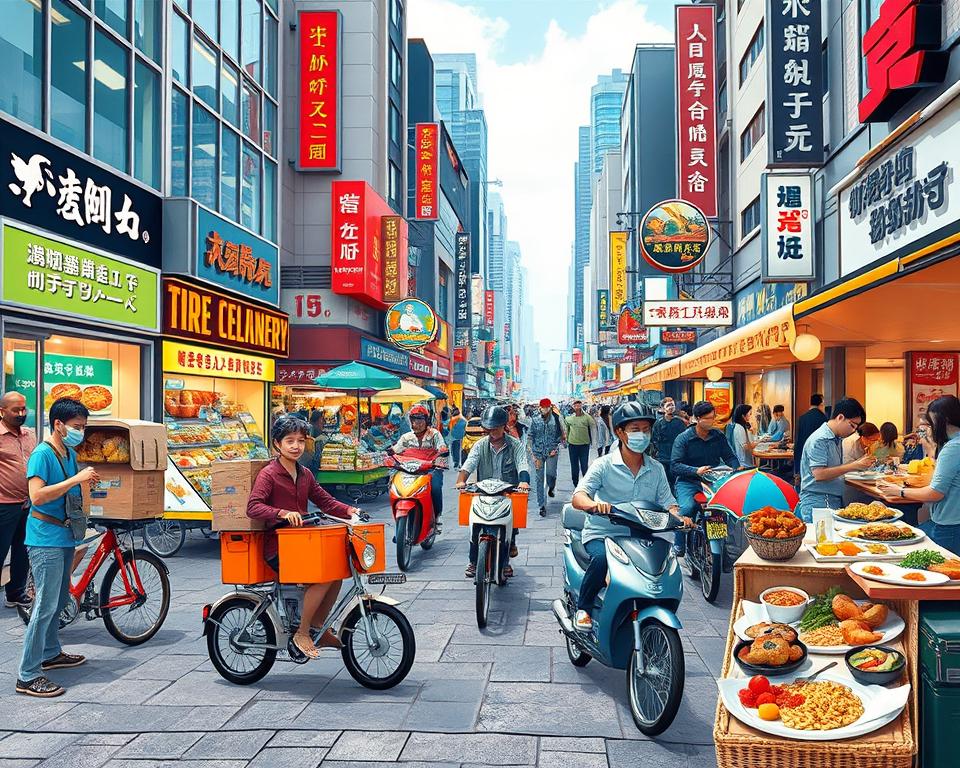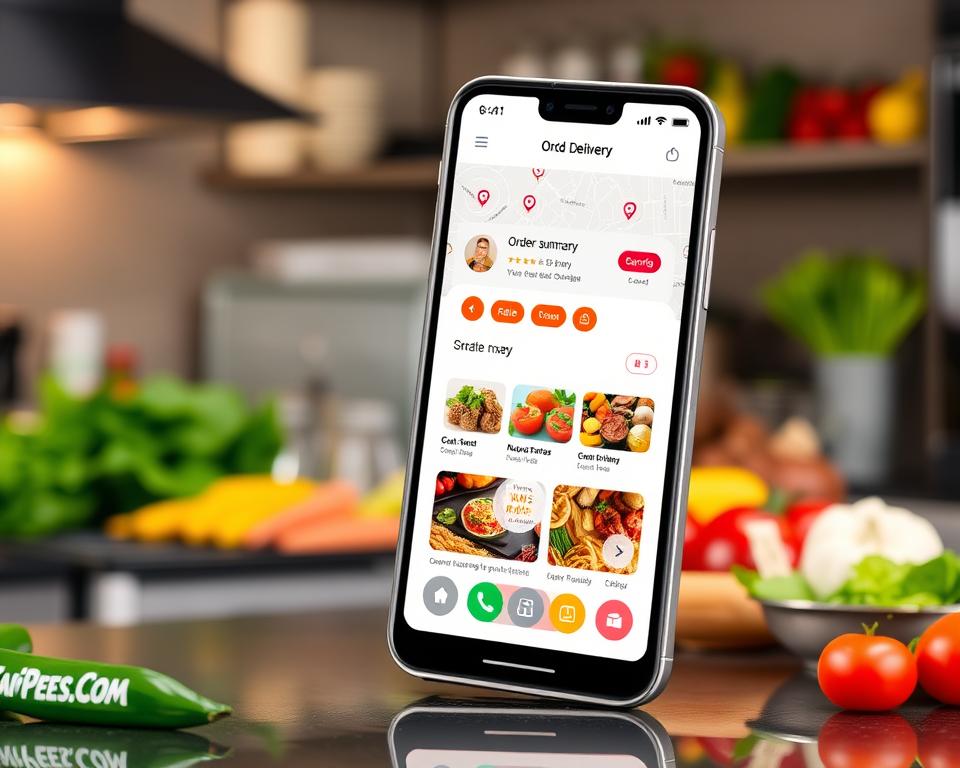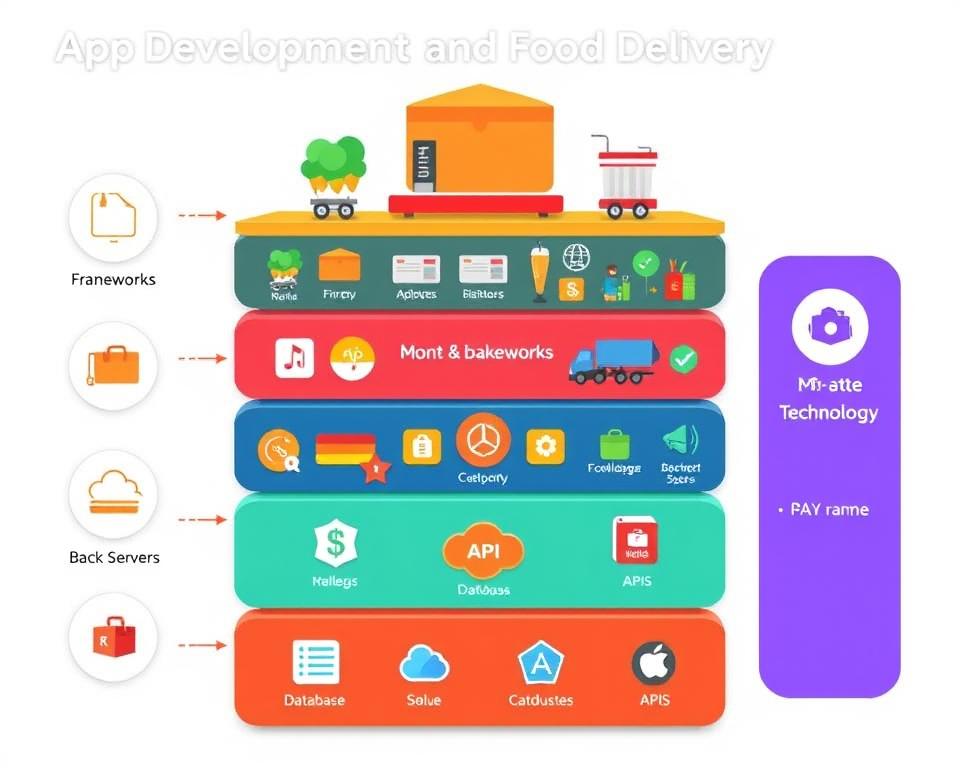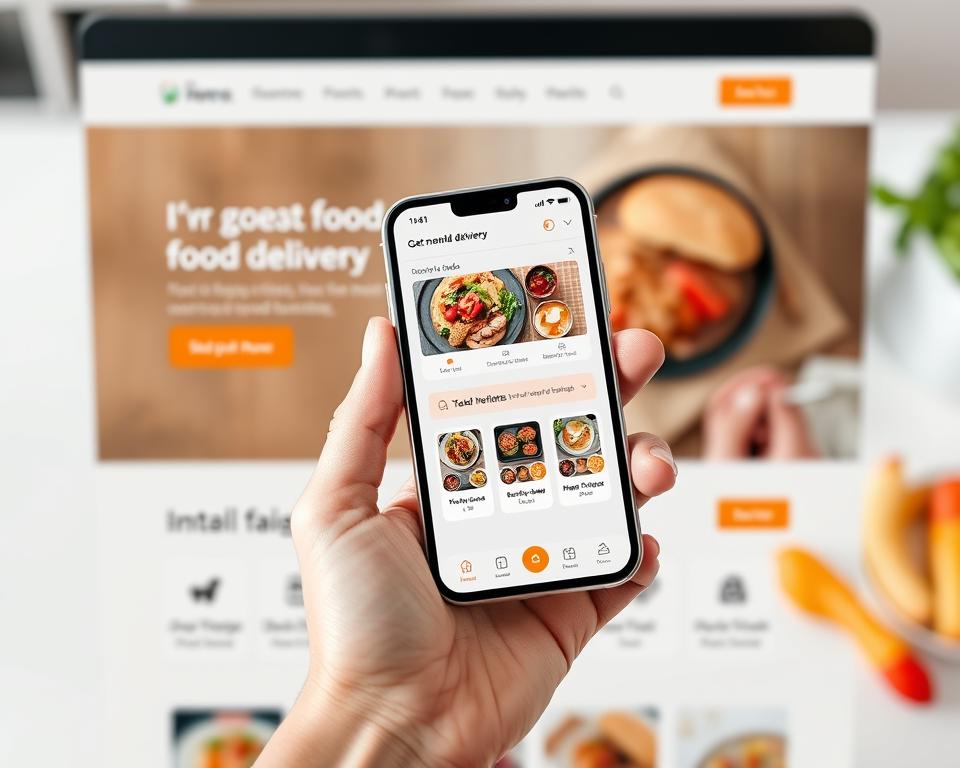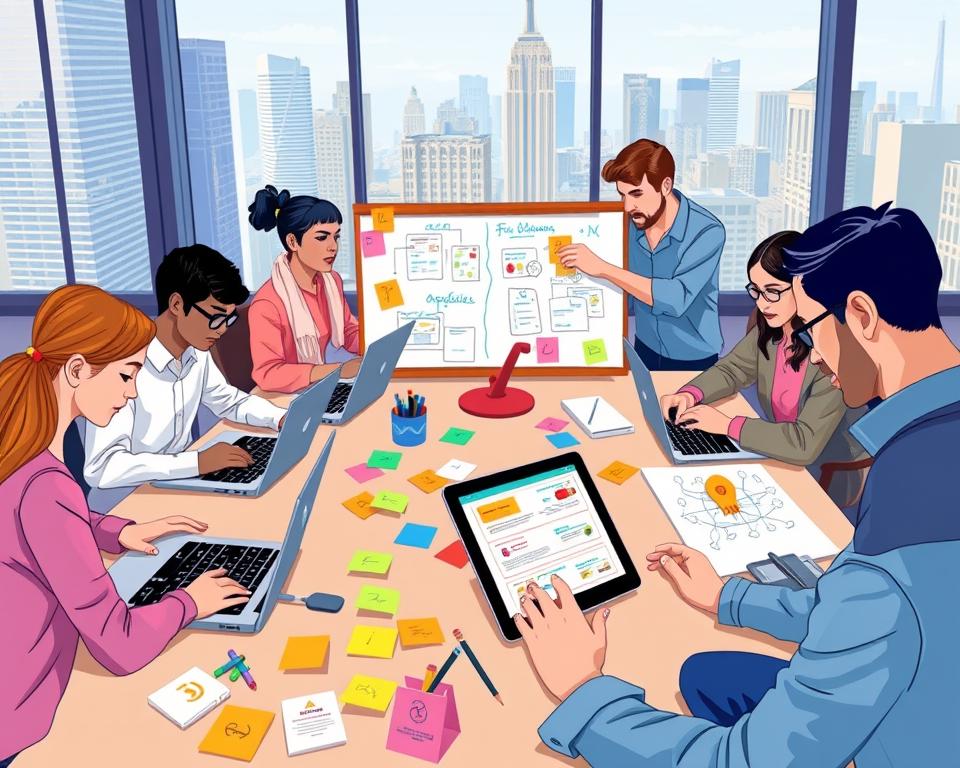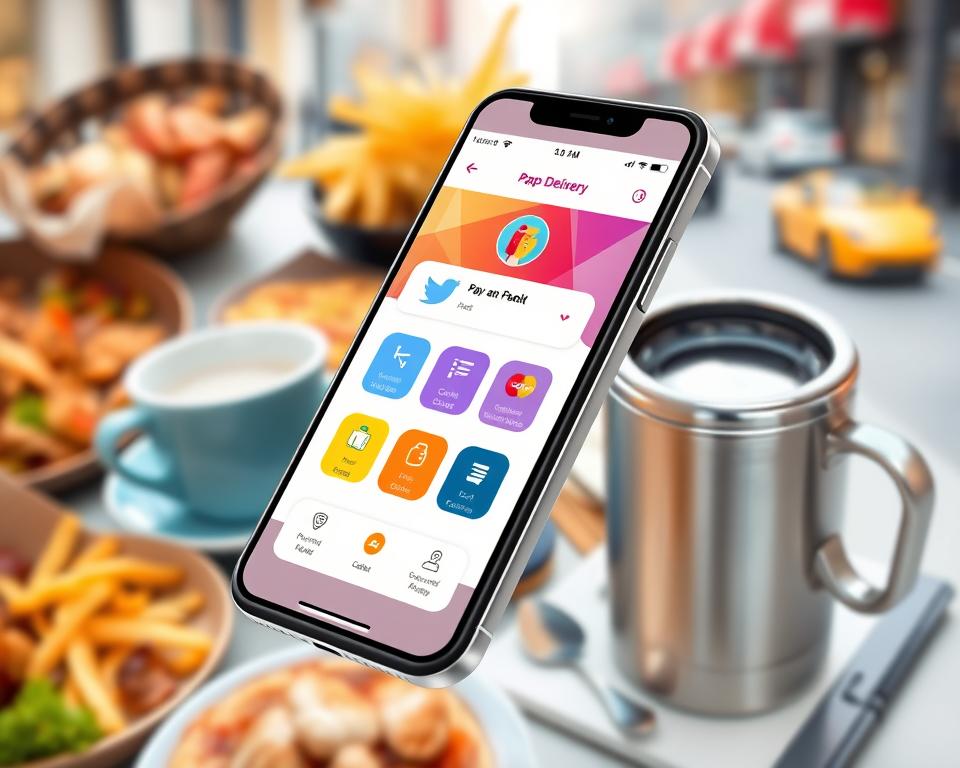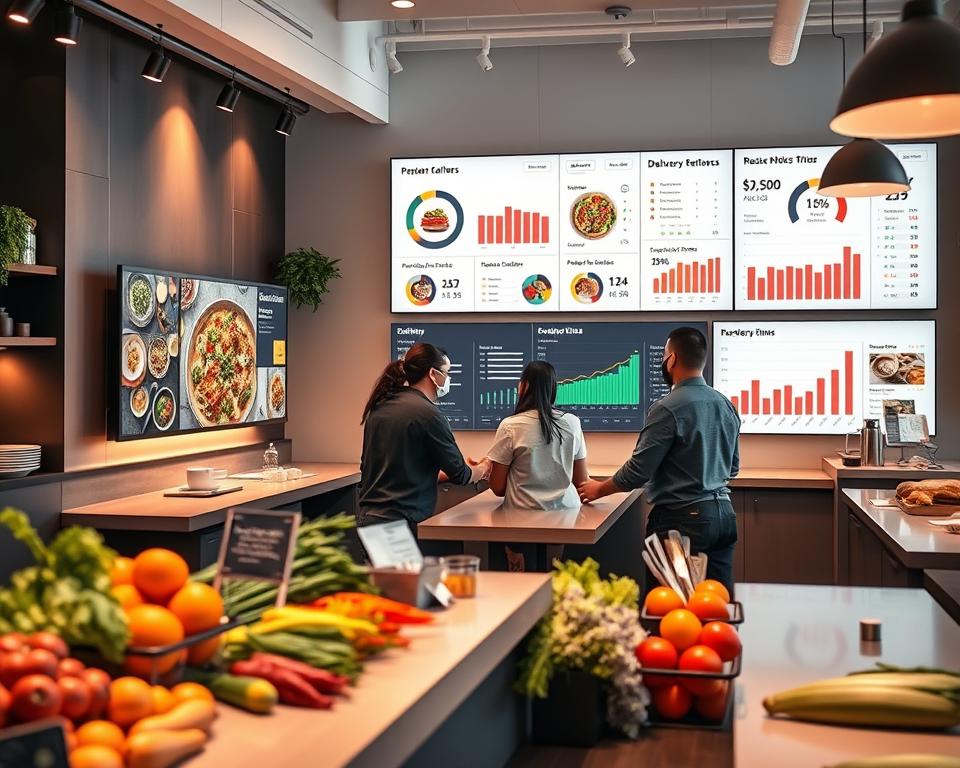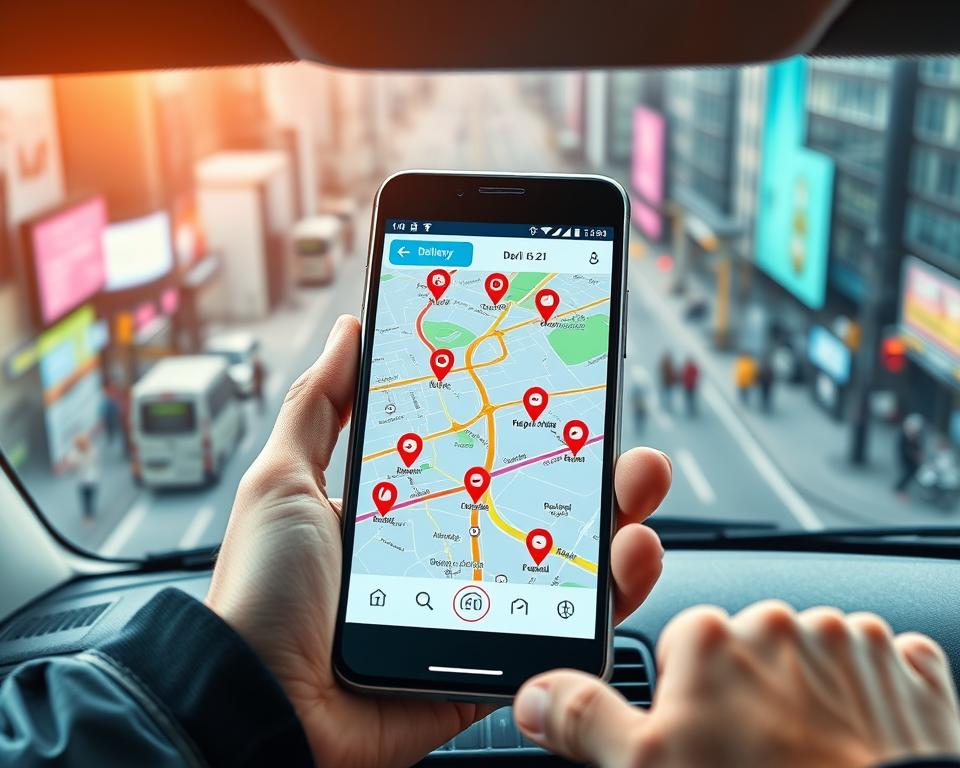In today’s fast world, people want food delivered quickly and easily. Food delivery app development is booming, with GrubHub at the forefront. With more people wanting food delivered on demand, businesses have a big chance to make money.
This article will show you how to make a food delivery app like GrubHub. We’ll cover the key features, technical needs, and how to make your app a success. If you’re starting a business or want to grow, this guide will help you understand the food delivery market.
Table of Contents
Key Takeaways
- Understand the current food delivery app market landscape, including market size, key players, and consumer behavior trends.
- Explore the essential features and technical requirements for building a GrubHub-like food delivery platform.
- Learn about user interface and experience design principles for creating an intuitive and engaging app.
- Discover strategies for payment gateway integration, location-based services, and delivery driver management.
- Gain insights into monetization models, marketing tactics, and scalability considerations for your on-demand food delivery app.
Understanding the Food Delivery App Market Landscape
The food delivery app market has grown fast in recent years. This growth comes from people wanting quick and easy meal options. The food delivery market is expected to keep growing, showing a bright future for this industry.
Current Market Size and Growth Projections
The global food delivery market is now worth over $150 billion. It’s set to grow at a rate of 11% each year from 2023 to 2028. This increase is due to the rise in food delivery apps, their convenience, and changing consumer habits since the COVID-19 pandemic.
Key Players and Their Market Share
| Top Food Delivery Apps | Market Share |
|---|---|
| GrubHub | 23% |
| DoorDash | 35% |
| Uber Eats | 20% |
| Postmates | 8% |
| Others | 14% |
Consumer Behavior Trends in Food Delivery
The food delivery industry has seen a big change in consumer preferences lately. People want their food delivered faster, with more choices, and easy to track. They also prefer healthier and sustainable food options, which has changed what restaurants offer through delivery.
- Convenience and speed are top priorities for food delivery customers.
- Personalized recommendations and customization options are highly valued.
- Increased interest in local, organic, and environmentally-friendly food options.
- Contactless delivery and digital payment methods have become the norm.
It’s important for food delivery app developers and providers to understand these consumer behavior trends. This helps them keep up with market demands and stay competitive.
Essential Features of a Successful Food Delivery Platform
To make a food delivery app thrive, it needs key features. These features should meet the needs of customers, restaurants, and drivers. They make the app user-friendly and efficient, helping it stand out in the market.
At the heart of a great app are several important parts. Customers can easily look at menus, make their orders, and see where their food is. Restaurants get tools to handle orders, update menus, and talk to drivers.
Adding food delivery app features for everyone is key. By focusing on user experience and platform functionality, apps can keep customers happy. They also build strong ties with restaurants and attract good drivers.
| Customer Features | Restaurant Features | Driver Features |
|---|---|---|
|
|
|
With these food delivery app features, platforms can create a smooth system. It meets the needs of all, leading to happy customers, engaged restaurants, and loyal drivers.
Technical Requirements for Building a GrubHub-like Application
Creating a food delivery app like GrubHub needs careful planning. It requires a solid app development stack, backend, and frontend technologies. These parts work together to offer a smooth user experience and efficient backend operations.
Backend Infrastructure Requirements
The backend of a food delivery app is its core. It must handle lots of traffic, process data in real-time, and keep data safe. Key backend needs include:
- Scalable server architecture to handle more users
- Reliable cloud hosting for uptime
- Efficient APIs for smooth integration
- Strong security for user data and transactions
- Scalable databases for customer and order info
Frontend Development Technologies
The frontend is what users see and interact with. It needs the right technologies for a good user experience. Important frontend tools include:
- Responsive web design frameworks like React.js, Angular, or Vue.js
- Progressive Web App (PWA) technologies for web app experiences
- Geolocation APIs and mapping services for location-based features
- UI/UX libraries and design tools for attractive interfaces
Database Architecture Considerations
The database is key for storing and managing lots of data. It includes customer info, menus, and order history. Important database design factors include:
| Consideration | Importance |
|---|---|
| Data Scalability | Handling more data without slowing down |
| Data Consistency | Keeping data reliable and consistent |
| High Availability | Keeping the app up and running |
| Disaster Recovery | Protecting against data loss |
By focusing on these technical needs, developers can build a GrubHub-like app. It will offer a smooth user experience and a strong backend.
User Interface and Experience Design Principles
Making a great food delivery app needs a focus on UI/UX design. This means making the app easy to use and centered on the user. By focusing on clear navigation, layouts that work well on all devices, and good looks, developers can make an app that users love.
Good UI/UX design starts with knowing what users like and need. Doing lots of user research, making detailed user profiles, and testing the app over and over is key. This helps make an app that really speaks to its users.
- Streamlined Navigation: Make the app easy to navigate, from picking a menu to tracking your order.
- Responsive and Adaptive Design: Make sure the app looks and works great on all devices, big or small.
- Visually Appealing Aesthetics: Use great images, simple icons, and a clean design to make the app look good.
- Intuitive Interactions: Use easy-to-use features like swiping and tapping to make the app fun and efficient.
By focusing on UI/UX design, developers can make an app that’s not just useful but also enjoyable. This builds trust, keeps users coming back, and helps the app succeed in the long run.
| Design Principle | Description | Impact on Food Delivery App |
|---|---|---|
| Simplicity | A simple and easy-to-use interface, free from clutter. | Makes the app easier to use, reduces stress, and makes users happier. |
| Responsiveness | The app works well on all devices, giving a consistent experience. | Makes the app more accessible, keeps users engaged, and strengthens the brand. |
| Personalization | The app is customized to fit each user’s preferences and habits. | Builds a sense of connection, keeps users loyal, and boosts satisfaction. |
| Feedback and Interactivity | The app gives clear feedback and has interactive features. | Boosts confidence, lowers frustration, and makes the app more fun and interactive. |
By following these UI/UX design principles, developers can make an app that’s not just useful but also enjoyable. This builds trust, keeps users coming back, and helps the app succeed in the long run.
Creating an On-Demand Food Delivery App Like GrubHub
To make a successful food delivery app, you need a solid app development process. It’s also important to focus on project management and quality assurance. Let’s look at the main parts that help make an app like GrubHub.
Development Phases and Timeline
The journey to create an app has several key steps:
- First, you gather and analyze the requirements.
- Then, you design the user interface (UI) and user experience (UX).
- Next, you set up the backend infrastructure.
- After that, you start the frontend development.
- You also integrate third-party services like payment gateways and mapping.
- Testing and quality assurance come next.
- Finally, you deploy the app and keep it updated.
The time it takes to make an app like GrubHub can be from 6 to 12 months. This depends on the project’s complexity and the team’s size.
Resource Allocation and Team Structure
Creating a strong food delivery app needs a diverse and skilled project management team. The main team members are:
- Project manager
- Business analyst
- UI/UX designers
- Backend developers
- Frontend developers
- Quality assurance (QA) engineers
- DevOps engineers
The team’s size and roles can change based on the project’s scope and the development method (e.g., Agile, Waterfall).
Quality Assurance Processes
Ensuring the quality assurance of the app is key to its success. This includes:
- Thorough testing (functional, integration, performance, security)
- User acceptance testing (UAT) to check the app’s usability and speed
- Continuous integration and deployment to keep the code quality and stability
- Monitoring and fixing user feedback and bug reports
By following a detailed app development process, using resources wisely, and focusing on quality assurance, you can build a food delivery app like GrubHub. It will offer a smooth user experience and meet the market’s changing needs.
Payment Gateway Integration and Security Measures
Creating a successful on-demand food delivery app like GrubHub needs a strong payment processing system. It’s key to ensure safe and reliable financial transactions. This builds trust with users and makes ordering smooth.
For transaction security, food delivery apps must follow top standards. They must protect customer data, like credit card info and personal details, with PCI compliance. Working with trusted payment gateway providers helps. Your app can then use advanced encryption and fraud checks for every transaction.
- Offer a variety of payment options, including credit/debit cards, digital wallets, and mobile payment solutions.
- Ensure secure data storage and transmission through industry-standard encryption protocols.
- Implement robust fraud detection and prevention measures to identify and mitigate potential risks.
- Regularly audit and update your payment systems to address evolving security threats and regulatory requirements.
| Payment Option | Benefits | Security Considerations |
|---|---|---|
| Credit/Debit Cards | Widely accepted, familiar to customers | Require PCI compliance, fraud detection |
| Digital Wallets | Convenient, mobile-friendly, secure tokenization | Integration with digital wallet providers |
| Mobile Payments | Seamless, contactless, tap-to-pay experience | Secure Near-Field Communication (NFC) technology |
By focusing on payment processing security and offering many payment choices, your app can gain customer trust. It also reduces financial risks and offers a smooth ordering experience.
“Integrating a secure and user-friendly payment gateway is crucial for the success of any on-demand food delivery platform. It’s a key element that can make or break the customer experience.”
Location-Based Services and Mapping Integration
In the world of on-demand food delivery, using geolocation services and GPS tracking is key. It makes the experience better and the delivery smoother. Apps like GrubHub have changed the game by adding these advanced technologies. Now, customers can track their orders in real-time and enjoy hassle-free delivery.
GPS Technology Implementation
GPS technology is at the heart of location-based services in food delivery apps. It uses the global positioning system to find the user’s, restaurant’s, and driver’s locations in real-time. This data lets customers see their order’s status from start to finish.
Real-Time Tracking Features
- Real-time order tracking: Customers can watch their order’s journey on a map as the driver heads to their place.
- Estimated time of arrival (ETA) updates: Customers get updates on when their food will arrive, based on the driver’s location and traffic.
- Driver location sharing: Customers can see the driver’s location on the map, making the delivery process more transparent and reassuring.
These features make the user experience better and the delivery process more efficient. By offering real-time tracking and transparency, apps like GrubHub can make their operations better. This leads to faster and more reliable delivery for customers.
“Integrating geolocation services and GPS tracking is a game-changer in the on-demand food delivery industry. It empowers customers with real-time visibility and helps deliver a seamless, efficient experience.”
Restaurant Partner Management System
In the world of on-demand food delivery apps, working well with restaurant partners is key. The restaurant onboarding process, menu management, and order processing are vital. They form the heart of a good restaurant partner management system.
Getting restaurants to join should be easy and quick. They should be able to sign digital contracts and set up their business profiles fast. Real-time menu updates are also important. This makes it easy to keep menus fresh and up-to-date.
Good menu management is essential too. Restaurants need to be able to change their menus easily. This includes updating item descriptions, prices, and availability. It helps keep customer orders accurate and reduces mistakes.
| Feature | Benefit |
|---|---|
| Automated order processing | Streamlined order management, reducing manual errors and improving efficiency |
| Real-time order tracking | Increased transparency and customer satisfaction |
| Flexible payment options | Accommodating diverse customer preferences and ensuring seamless transactions |
The order processing part of the system is also very important. Automating orders, tracking, and payments makes things run smoother. It cuts down on mistakes and keeps everyone happy.
“Effective restaurant partner management is the key to building a thriving on-demand food delivery ecosystem.”
By focusing on onboarding, menu management, and order processing, the app can build strong relationships with restaurants. This helps the app grow and succeed in the on-demand food delivery world.
Delivery Driver App Development
The driver app is key for on-demand food delivery success. It ensures fast and efficient deliveries. A good driver app is crucial for a GrubHub-like platform. It needs a user-friendly design and smart route features.
Driver Interface Design
The driver app should be easy to use. It should have clear order details and efficient ways to accept orders. It should also have real-time tracking and navigation tools.
Having a simple app helps delivery drivers focus. It reduces mistakes and improves service to customers.
Route Optimization Features
Route optimization is vital for the driver app. It makes deliveries faster and cheaper. The app should use smart algorithms to:
- Analyze traffic and road conditions
- Find the best routes for each delivery
- Update routes as conditions change
- Give drivers clear directions and arrival times
With route optimization, drivers can better navigate cities. This reduces delivery times and boosts customer happiness.
Creating a great driver app is essential for a food delivery platform. Focus on easy design and smart route optimization. This empowers delivery drivers to offer top-notch service and help the platform succeed.
Order Processing and Management System
At the heart of a successful on-demand food delivery app like GrubHub is the order processing and management system. This key part makes sure orders are filled smoothly, from when a customer orders to when it’s delivered. Good order management keeps customers happy and makes things run smoothly.
One important feature is automated dispatching. This lets the app send orders to the closest drivers. It makes delivery faster and better. This makes customers happier and helps the app track orders better.
- Real-time order status updates for customers
- Automated driver assignment and route optimization
- Detailed order management dashboards for restaurant partners
Advanced algorithms and data help the system manage orders well. Orders are filled quickly, making customers happy. This makes daily work easier and gives useful data for improvement.
| Key Features | Benefits |
|---|---|
| Automated Dispatching | Optimized delivery routes, reduced wait times |
| Real-Time Order Tracking | Improved customer experience, increased transparency |
| Order Management Dashboards | Enhanced visibility and control for restaurant partners |
Having a strong order management system is key for a successful food delivery app. It makes the delivery process better, keeps customers happy, and helps the business grow.
Push Notification and Communication Features
In today’s fast world, keeping customers engaged is key. This is why push notifications and real-time communication are so important. They help keep customers loyal and coming back for more.
Customer Engagement Strategies
Building a great food delivery app starts with engaging customers. Push notifications help businesses stay in touch with their customers. They send timely updates, special offers, and important info.
These notifications can be customized for each user. This way, customers get the most relevant and interesting content.
- Notify customers about special promotions, discounts, and limited-time offers to drive impulse purchases.
- Update customers on the status of their orders, from the moment the food is prepared to its arrival at their doorstep.
- Encourage feedback and reviews by sending push notifications after a successful delivery, fostering a sense of community and improving the overall service.
Real-Time Updates Implementation
Real-time communication is crucial in on-demand food delivery. Customers want updates from start to finish. Adding real-time features to your app can make a big difference.
- Implement GPS tracking to provide customers with live updates on the status of their order and the estimated time of arrival.
- Offer real-time notifications for order confirmation, preparation updates, and delivery confirmations to keep customers engaged and informed.
- Leverage in-app chat or messaging features to enable seamless communication between customers and restaurant staff, addressing any queries or concerns in a timely manner.
By using push notifications and real-time features, food delivery apps can engage customers better. This leads to more loyal customers and more repeat business.
Analytics and Reporting Dashboard
In the fast-paced world of food delivery, data is crucial for growth and improvement. The analytics and reporting dashboard is key for food delivery app operators. It helps them make smart choices with data analytics, performance metrics, and business intelligence.
This dashboard offers a wide range of metrics for a full view of the app’s performance. It tracks everything from order volume and customer engagement to delivery times and driver productivity. This gives businesses the tools to spot issues, improve workflows, and keep getting better.
| Key Performance Metric | Importance |
|---|---|
| Order Completion Rate | Shows how well the delivery process works and where to improve. |
| Customer Satisfaction Score | Gives insights into how users feel, helping to make things better. |
| Driver Utilization Rate | Helps use delivery staff efficiently, making sure they’re doing their best. |
| Revenue per Order | Keeps an eye on the app’s money side, guiding pricing and commission plans. |
The analytics dashboard uses advanced visuals to share these insights clearly. This helps leaders spot trends, find new chances, and make choices based on data. These choices can move the business forward.
“The analytics dashboard is the heartbeat of our food delivery app, providing us with the critical insights needed to optimize operations and stay ahead of the competition.”
Adding a strong analytics and reporting dashboard is vital for a food delivery platform’s success. With data analytics, performance metrics, and business intelligence, operators can improve their business. They can also make the customer experience better and set their business up for long-term success.
Monetization Strategies and Revenue Models
In the world of food delivery apps, making money is key to success. As the market changes, app makers are finding new ways to earn. They focus on commission structures and subscription services to boost profits.
Commission Structure Planning
Many apps use a commission model. Restaurants pay a percentage of each order to the app. This can be 15% to 30% of the total order value. App developers plan this carefully to make a steady income and stay competitive.
Subscription Service Options
Apps also offer subscription services. These plans give users special perks like free delivery or discounts. By getting users to subscribe, apps get a steady income and keep users engaged.
Apps that succeed mix different ways to make money. They balance commission rates, subscription plans, and other earnings like ads. By keeping up with trends and what users want, they build a strong business that lasts.
Marketing and User Acquisition Strategies
In the world of food delivery apps, marketing and getting users are key. To be noticed and keep users coming back, app marketing and growth hacking are vital. They help you stand out and build a loyal user base.
Social media is a powerful tool. By making engaging content and running ads, you can reach more people. Working with influencers and using customer reviews can also help build trust.
Another good strategy is to partner with local restaurants and food blogs. This can help you get more users. Offering discounts and rewards can also keep users coming back.
| Marketing Channel | Potential Impact | Key Considerations |
|---|---|---|
| Social Media Advertising | Targeted reach and engagement | Optimize ad campaigns, leverage user-generated content |
| Influencer Marketing | Leveraging trusted voices | Identify relevant influencers, create authentic collaborations |
| Partnerships and Cross-Promotions | Expanded audience and credibility | Align with complementary brands, offer value-added incentives |
By using a smart growth hacking plan, you can get and keep users. This plan includes new marketing ideas, partnerships, and focusing on user interaction. It helps food delivery apps succeed in the competitive market.
Scaling and Performance Optimization
Food delivery apps like GrubHub are getting more popular. They need to scale and optimize their performance. This is key to keeping users happy and meeting the demand for food delivery.
Load Balancing Solutions
Handling more user requests is a big challenge. Load balancing solutions help by spreading the workload. This prevents slow downs and keeps the app running smoothly.
Algorithms like round-robin or least-connection help manage resources. They ensure the app stays fast and reliable.
Database Optimization Techniques
The app’s database is crucial for storing data. This includes menus, user info, and order details. Optimizing the database improves the app’s performance and scalability.
Techniques like indexing and query optimization are key. Regular maintenance keeps the data flowing smoothly.
| Optimization Technique | Description |
|---|---|
| Indexing | Creating indexes on frequently queried columns to improve search and retrieval performance. |
| Query Optimization | Analyzing and rewriting database queries to minimize resource usage and execution time. |
| Data Partitioning | Dividing the database into smaller, more manageable segments to enhance load balancing and performance optimization. |
By using these strategies, food delivery apps can grow smoothly. They keep their performance high, even with more users and orders.
Conclusion
In the fast-changing food delivery app market, starting a successful platform like GrubHub requires a detailed plan. Understanding the market, adding key features, and using the latest tech are crucial. These steps help create a smooth user experience.
We’ve looked at what’s needed for a food delivery app, from the backend to payment and driver management. Focusing on the user, using location services, and improving efficiency are key. These strategies help new players stand out and gain a big share of the market.
As more people want food delivered quickly, businesses that plan well and innovate will do well. By following the advice in this article, entrepreneurs can tackle the challenges of the food delivery app world. They can build a platform that meets today’s high standards for ease, speed, and top-notch service.








